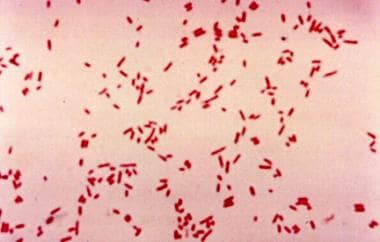Background
Food-borne illnesses are diverse in etiology, and food poisoning can follow ingestion of infectious organisms or noninfectious substances. Food-borne diseases (FBDs) constitute a serious public health problem in the United States. FBDs encompass classic toxin-mediated food poisoning, such as botulism; gastroenteritis that follows ingestion of preformed Staphylococcus aureus toxin; ingestion of chemicals in foods; and bacterial (see the image below), parasitic, and viral infections. Many FBDs are zoonoses, which implies that the infectious agent has a primary animal reservoir and that humans are affected incidentally.
See 5 Cases of Food Poisoning: Can You Identify the Pathogen?, a Critical Images slideshow, to help identify various pathogens and symptoms related to foodborne disease.
Pathophysiology
Although the GI tract is the primary target, autonomic nervous system disturbances and CNS impairment are prominent manifestations in chemical-related, plant-related, and seafood-related poisonings and in botulism. The severity of dehydration can vary depending on the pathogen.
Typically, FBDs in which severe vomiting (eg, staphylococcal-toxin gastroenteritis) and small bowel diarrhea occur, typified by Vibrio cholerae infection, can cause life-threatening dehydration. Other organs involved include the liver in hepatitis A, muscles in trichinosis, lymph nodes in toxoplasmosis, and, importantly, the kidneys in hemolytic-uremic syndrome (HUS), which follows enterohemorrhagic Escherichia coli -induced diarrhea.
See the image below.
Epidemiology
United States data
The US Centers for Disease Control and Prevention (CDC) estimates 1 in 6 Americans (48 million people) are affected by foodborne illness annually. The estimates suggest 128,000 people are hospitalized and 3,000 die. [1] The 31 known pathogens account for an estimated 9.4 million annual cases, 55,961 hospitalizations, and 1,351 deaths. Unspecified agents account for 38.4 million cases, 71,878 hospitalizations, and 1,686 deaths. [2]
The most common pathogens are as follows [1] :
-
Norovirus – 5,461,731 cases
-
Salmonella – 1,027,561
-
Clostridium perfringens – 965,958
-
Campylobacter species – 845,024
-
Staphylococcus aureus – 241,148
The most common pathogens responsible for hospitalizations are as follows [1] :
-
Salmonella – 19,336 hospitalizations
-
Norovirus – 14,663 hospitalizations
-
Campylobacter species – 8,463 hospitalizations
-
Toxoplasma gondii – 4,428 hospitalizations
-
E coli – 2,138 hospitalizations
The pathogens most commonly associated with death are as follows [1] :
-
Salmonella – 378 deaths
-
T gondii – 327 deaths
-
Listeria monocytogenes – 255 deaths
-
Norovirus – 149 deaths
-
Campylobacter species – 76 deaths
The CDC recognized the following outbreaks and sources in 2012 [1] :
-
E coli – Spinach and spring mix, raw clover sprouts at Jimmy John’s restaurants
-
Salmonella – Peanut butter, FrescolinaMarte brand ricotta salata cheese, mangoes, cantaloupe, ground beef, live poultry, dry dog food, raw scraped ground tuna product, small turtles, raw clover sprouts
International data
International statistics are probably impossible to compute, but the obvious relevance of worldwide FBDs is the risk to travelers in the very mobile American and world population and the estimated 2 million deaths in children alone. [3, 4, 5]
Race-, sex-, and age-related demographics
No specific racial predilection is noted, except that invasive Salmonella infections are more prevalent in individuals with hemoglobinopathies, which, in turn, are more common among people of African and Mediterranean descent.
No sex predilection is known for any food-borne illness; however, Listeria infection is often severe and life-threatening in pregnant women.
The CDC found that 5 bacterial enteric pathogens (Campylobacter, E coli 0157 , Salmonella, Shigella, and Y enterocolitica) caused 291,162 illnesses annually in children younger than 5 years. [6] This resulted in 102,746 doctor visits, 7,830 hospitalizations, and 64 deaths. Rates of illness remain higher in children.
Prognosis
Morbidity/mortality
The epidemiologic relevance of FBD is that outbreaks can involve an immense number of individuals and have the potential to overwhelm local health care services. Death can occur in a small proportion of affected patients; therefore, practitioners must take responsibility for reporting suspected FBDs and participate in investigations by the agency (eg, by saving food or vomitus samples).
-
Escherichia coli on Gram stain. Gram-negative bacilli.








